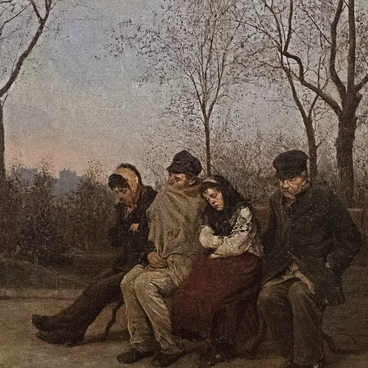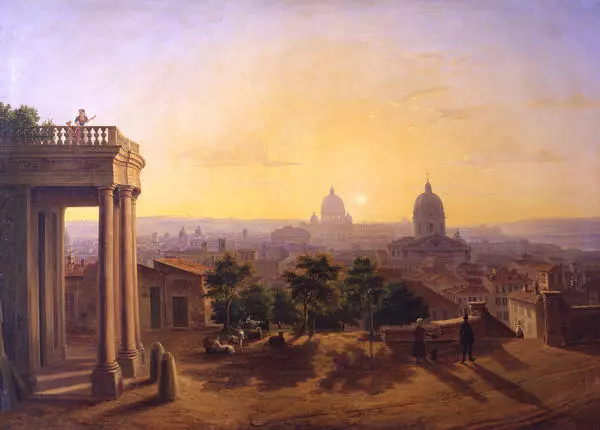The landscape genre developed quite late in Russia — in the second half of the 18th century, but already in the 19th century, it began to gain rapid momentum. Artists created works in different styles: academic, romantic, and later realistic as well.
Maxim Vorobyov was not only a famous landscape painter, but also a teacher who trained dozens of artists. The most famous of his students was Ivan Aivazovsky.
Vorobyov became an artist by chance. His father, who retired at the rank of a junior officer, got employed as a custodian at the Academy of Arts. In 1797, this enabled him to enroll his ten-year-old son Maksim in classes. The young artist showed particularly impressive results in drawing, mastering perspective techniques and landscape painting. His teacher was Fyodor Alekseev, the founder of the Russian cityscape genre. And in 1823, Vorobyov himself became a professor of landscape painting class.
In 1820, Vorobyov, on behalf of the Grand Duke Nikolai Pavlovich, the future Emperor Nicholas I, was the first Russian artist to visit Palestine. The purpose of the trip was to measure and sketch Christian sites. The difficulty was caused by the need to keep everything secret from the Muslim authorities. The artist managed to complete the task: he returned from the trip with almost a hundred watercolors, which became a basis for his future paintings.
‘The Black Sea Coast’ was one of Vorobyov’s works, painted under the impact of this trip. The ancient Constantinople (the modern Istanbul) was located on the shores of the Bosphorus, which divided the city into a European and an Asian part. The painting’s viewpoint was in the Asian part of the city — in the Skutari region (modern Uskudar). From there, one could see the European part of the city behind the strait waters — in a similar way, central Constantinople with its sacred sites is to be seen in the middle of the canvas.
Vorobyov designed the landscape composition in accordance with the scheme adopted at the Academy of Arts. The composition consists of three parts: the foreground is shadу, the central part is illuminated, and the background is light-hued and somewhat misty.
At the same time, in this painting, Vorobyov went beyond the strict principles of academic art. Thus, the linear perspective of the landscape was combined with the aerial one. The artist shortened the perspective of the background, and this makes the image disappear into a faint haze, the color loses its brightness, the contrasts become less pronounced — and some air is brought into the painting.
Maxim Vorobyov was not only a famous landscape painter, but also a teacher who trained dozens of artists. The most famous of his students was Ivan Aivazovsky.
Vorobyov became an artist by chance. His father, who retired at the rank of a junior officer, got employed as a custodian at the Academy of Arts. In 1797, this enabled him to enroll his ten-year-old son Maksim in classes. The young artist showed particularly impressive results in drawing, mastering perspective techniques and landscape painting. His teacher was Fyodor Alekseev, the founder of the Russian cityscape genre. And in 1823, Vorobyov himself became a professor of landscape painting class.
In 1820, Vorobyov, on behalf of the Grand Duke Nikolai Pavlovich, the future Emperor Nicholas I, was the first Russian artist to visit Palestine. The purpose of the trip was to measure and sketch Christian sites. The difficulty was caused by the need to keep everything secret from the Muslim authorities. The artist managed to complete the task: he returned from the trip with almost a hundred watercolors, which became a basis for his future paintings.
‘The Black Sea Coast’ was one of Vorobyov’s works, painted under the impact of this trip. The ancient Constantinople (the modern Istanbul) was located on the shores of the Bosphorus, which divided the city into a European and an Asian part. The painting’s viewpoint was in the Asian part of the city — in the Skutari region (modern Uskudar). From there, one could see the European part of the city behind the strait waters — in a similar way, central Constantinople with its sacred sites is to be seen in the middle of the canvas.
Vorobyov designed the landscape composition in accordance with the scheme adopted at the Academy of Arts. The composition consists of three parts: the foreground is shadу, the central part is illuminated, and the background is light-hued and somewhat misty.
At the same time, in this painting, Vorobyov went beyond the strict principles of academic art. Thus, the linear perspective of the landscape was combined with the aerial one. The artist shortened the perspective of the background, and this makes the image disappear into a faint haze, the color loses its brightness, the contrasts become less pronounced — and some air is brought into the painting.








